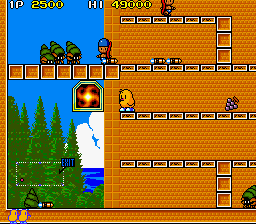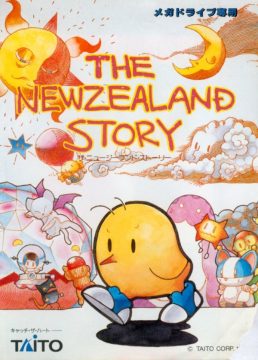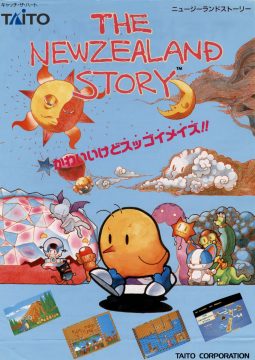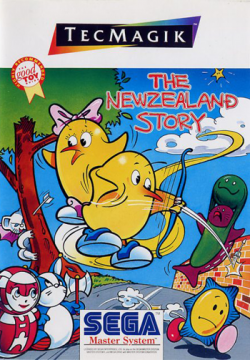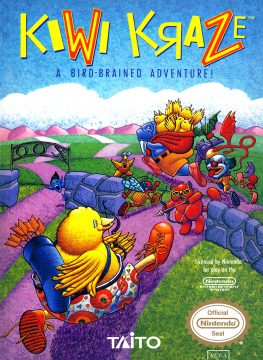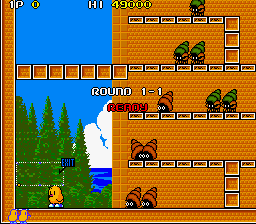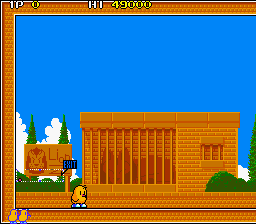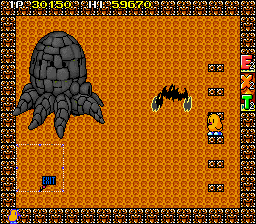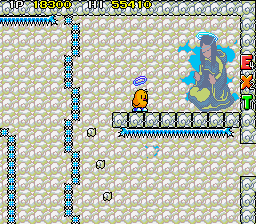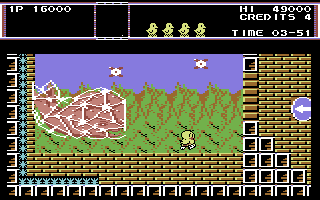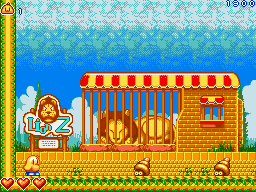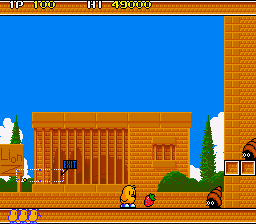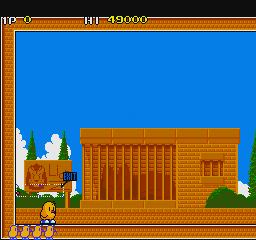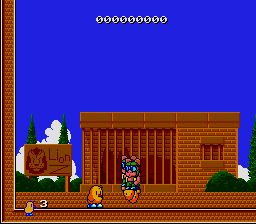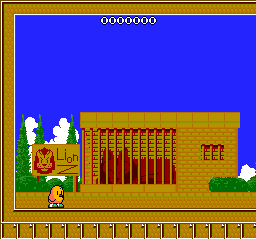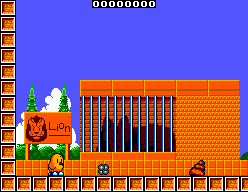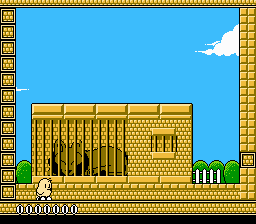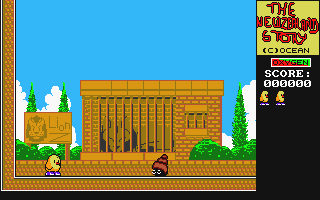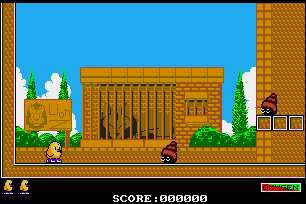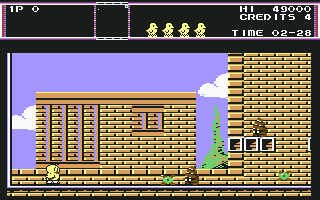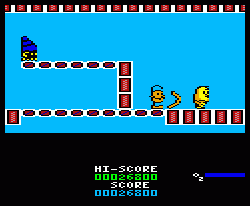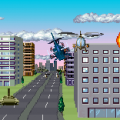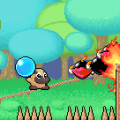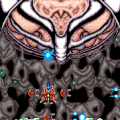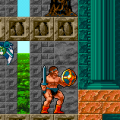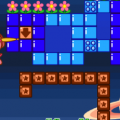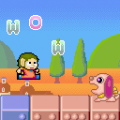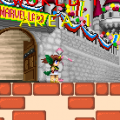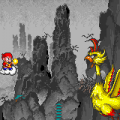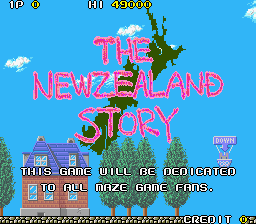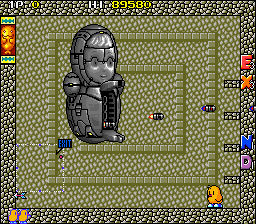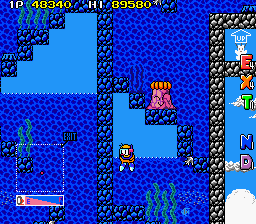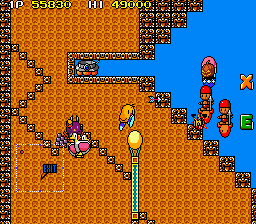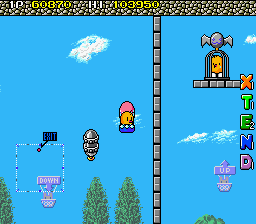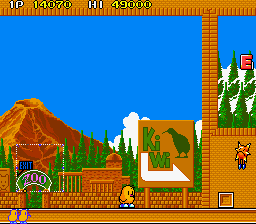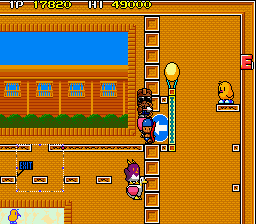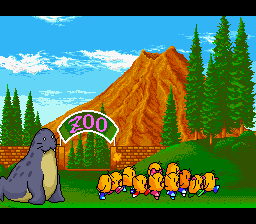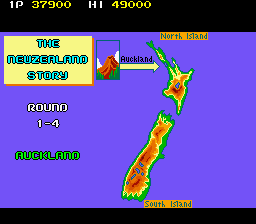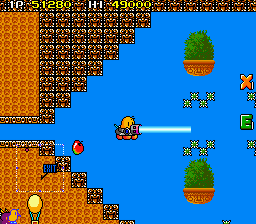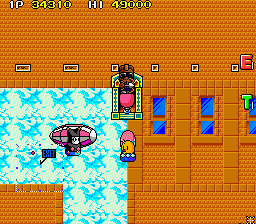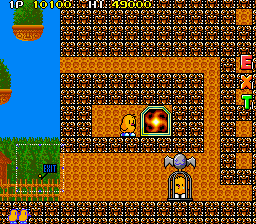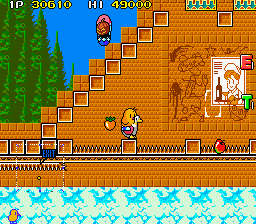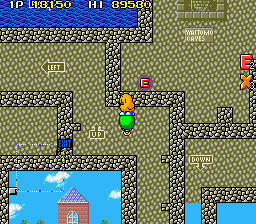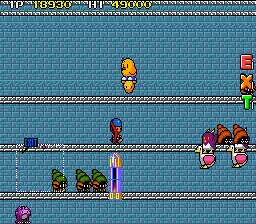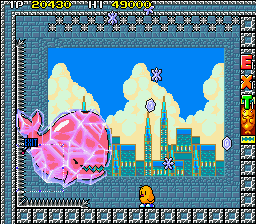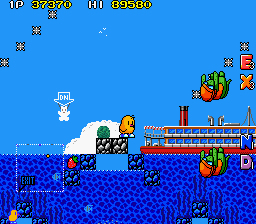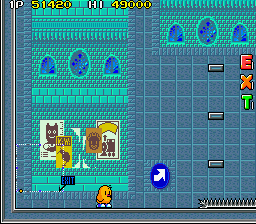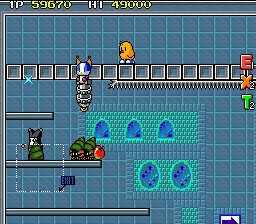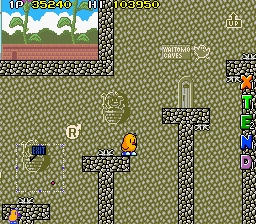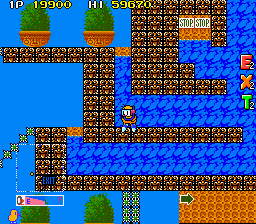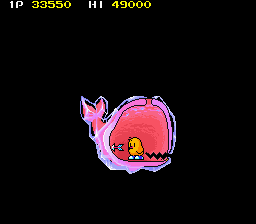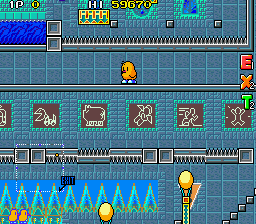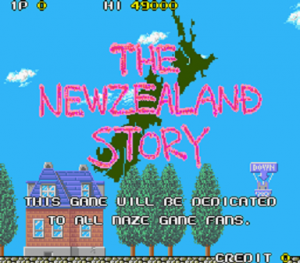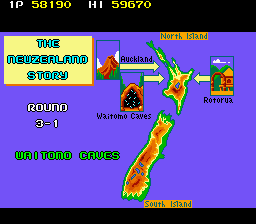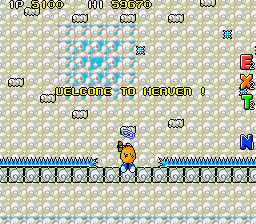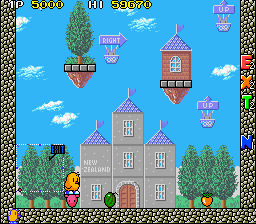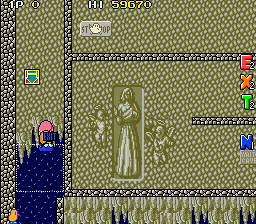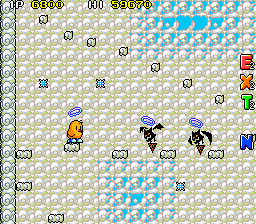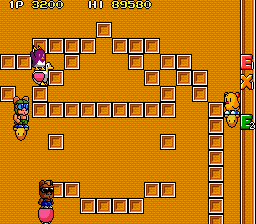- NewZealand Story, The
- New Zealand Story Revolution
CHECK COMPARISON ALIGNMENT
“This game will be dedicated to all maze game fans.”
This sentence appears during the attract mode of Taito’s The NewZealand Story arcade game. It takes a simple premise – you are in a maze, find the exit – and, with the company’s unique style and flavor, turns it into a surreal, dream-like experience. It’s fun, albeit frustrating, largely because it’s much harder than what its cute graphics may suggest.
Fresh from the worldwide success of Bubble Bobble (1986), Taito most likely wanted to do another cutesy platform game, with the same simple plot of saving the damsel in distress. In The NewZealand Story, Tiki the kiwi must save his beloved Phee-Phee from the leopard seal that kidnapped her and other kiwis from the Auckland zoo, and sold them all over the country. However, the game itself is substantially different. Instead of single screen levels, most stages are quite large, extending in all directions, and the focus is on exploring the maps, to find the easiest and fastest way to the exit. This is easier said than done, because of all the twists, turns, secret passages, deadly spikes, underwater areas, narrow passageways and all that befits a true maze.
Tiki goes into the fray armed only with a bow and an endless supply of arrows (it is a fairly surreal game, after all). He also dies in a single hit. Luckily for him, there are a few elements that help him out. One is the mini-map that appears in the corner of the screen, which shows Tiki’s position, as well as location of a caged kiwi, which is the exit of the stage. Another important thing to note is that most enemies won’t directly harm him – only their weapons will. (Spiked enemies are obviously the exception.) This becomes useful when hijacking their vehicles. The levels are so huge that Tiki needs to borrow some means of transportation if he wants to explore everywhere. Additionally, there’s an invisible timer, so if you dawdle, a cute little red devil will chase him down and start stalking him. It’s invincible, of course, as a means of hurrying you to the exit.
There are different types of vehicles, including zeppelins and hot air balloons, each one with different weight, speed and maneuverability. They go from the cumbersome “metal balloon” – too slow, heavy and big to successfully navigate the maze – to the awesome UFO – very fast, unaffected by gravity and inertia, almost indestructible and with a devastating laser beam that also goes through walls! To steal a vehicle, Tiki simply has to jump onto it, which shoves out the enemy piloting it. (Grand Theft Auto has nothing on him.) Among the many bonuses the game offers include the EXTEND letters from Bubble Bobble that give an extra life, and a joystick that removes inertia and gravity from the vehicles (i.e. you don’t have to press the jump button to move them), making them all control like the UFO. Be careful though – the vehicles are still vulnerable to enemy fire and other hazards, and Tiki can still be killed if the attack hits him directly.
Another interesting feature are the warps, portals that let you skip zones, which appear by shooting in empty corners of the levels. As is the case with every arcade game in the 80s that featured secrets (many of them were crammed in Taito platformers of the time), this keeps players looking in every nook and cranny to find them. The original Japanese arcade version has a warp in stage 1-4 that takes Tiki to stage 2-1 and another one in that level that brings him back to 1-4, thus allowing skilled players to go on to play indefinitely and rack up huge amounts of points and extra lives. A later version put a stop to this by putting some blocks between Tiki and the warp, and then modifying the layout of the levels.
There are actually four different ROM sets (with five designations in MAME) with various differences. These include the original Japanese arcade release (Japan, Old), the original worldwide release (World, New), the revised versions, which include an add-on arcade board with an additional Z80 processor (World and Japan, New), and a prototype version used for location tests (Japan, prototype). All of them are called New Zealand Story, with no specific indicators other than different looking title screens. The changes include different level orders, altered level layouts, and changed warp positions. The “New” versions also have improved graphics in areas. Most of the home ports are based on the original Japanese arcade game. The original World release is much more difficult than the other versions, with more spikes and enemies.
Comparison between the beginning of the game in older and newer ROM set.
It’s not known why the development team chose a real life location to set the game in (it seems that one Taito employee went on holiday there and wanted to make a game about the places he’d seen), because outside of the New Zealand map that appears between the stages and the names of the zones such as Auckland, Rotorua, Mount Cook etc., the environments have very little to share with their counterparts. For one, there actually aren’t so many spikes around. Our hero Tiki is supposedly based on New Zealand’s animal mascot, the kiwi bird, but looks nothing like it, instead resembling an animesque chick with sneakers on his feet. Some posters in the background have a realistic kiwi silhouette on them, and the difference is noticeable. You can let him flap his wings and hover a little if you press rapidly the jump button while falling, whereas in real life kiwis are flightless birds.
Similarly, his foes aren’t examples of the real-life fauna that populates that country, but are a strange bunch of Sanrio-esque cute critters (most of which pour out of portals appearing out of thin air) including, but not limited to, hermit crabs shooting bullets, punk teddy bears, wooden puppets, bat-winged cats, lambs with cannons, purple penguins riding floating rubber ducks, fire-breathing lizards on balloons, and self-replicating spiky things. Even weirder are the bosses, such as the infamous frozen whale that swallows Tiki whole, forcing him to kill the monster from inside his stomach. Not to mention the final enemy, the leopard seal (sometimes called “Wally Walrus”, but it’s a seal), who hangs from a balloon and is armed with a mortar.
The graphics reflect the dreamy, whimsical nature of the game. The backgrounds are a mishmash of cutesy stylized images (like the ones you can find on the walls of a kindergarten), posters, wall scribblings, pastel drawings, traffic signs and references to Christianity such as church-like stained glass windows and images of angels. (Christianity is the most prevalent religion in New Zealand, but what has this to do with anything?) And if a bow-and-arrow wielding bird sounded weird, the secondary weapons are even stranger – cartoon bombs that travel in an arc and explode with a “BOM” sound effect, a magic wooden staff that shoots up to two fireballs that bounce around, and a fast-shooting laser gun. Despite all this bizarreness, in the end everything gels together and the experience is ultimately enjoyable. That is, if you don’t get too frustrated with the impossibly convoluted layout of later levels, the absurd amount of spikes everywhere, the limited amount of time you can spend underwater, and the hordes of enemies relentlessly pouring out from the portals.
There is also a secret feature that happens only once and only on very specific circumstances: the ability to cheat death, or better, escape from the netherworld! If you lose your last life on any level between 3-x and 5-x, but only because of a solid projectile like arrows, bullets or stones, Tiki’s immortal soul will ascend to Heaven. (So that was the purpose of the Christianity references, perhaps!)
Maybe “immortal” is not the right word though, because Heaven is playable and plays like any other level, despite being made of fluffy clouds. There are loads of spikes and enemies (who, like Tiki, will all have a halo on their heads) and the goal is to reach the exit, which features not a cage, but a Virgin Mary-look-a-like called “The Goddess”. After having reached her, the player is given a short message and then the game will end. The message, however, ends with the sentence – “But the Heavens had got an exit to the underworld”. Indeed every Heaven (the Heaven level changes depending on the stage where you died) has a well-hidden escape route, and Tiki will be given another chance by restarting in the level after the one he died in, but a single time.
In the end, The NewZealand Story is a pretty original, and an enjoyable if difficult title, that however never became as popular as Bubble Bobble and the other cutesy Taito platformers. Tiki never had a major role again outside of the customary appearances in later games of the software house. It remains however an unique title in Taito’s arcade library, fondly remembered by retro arcade fans.
Between 1989 and 1992, the game was being ported for almost every home system that existed at the time. However, only few of these ports could be considered almost arcade perfect, namely the ones for Japanese computers such as the Sharp X68000 and FM Towns (ported by Ving). These are the only ones to feature both the Heaven rounds and the cinematic intro and ending sequences. The only perceivable changes are some minor differences regarding enemy behavior. All of the other ones had features missing, including some (or all) warps, some enemies, the in-game map and even the EXTEND letters. As stated above, almost all ports are based on the older Japanese ROM set
Some home computer versions (Amstrad CPC, ZX Spectrum, Atari ST) are based on the Amiga conversion by the “Choice” programming group published by Ocean Software, which is probably the best and most faithful computer conversion. This one is notorious because of an infamously profane cheat code that, when typed on the title screen, grants infinite lives: MOTHERFUCKENKIWIBASTARDS.
The Spectrum port is almost monochromatic, featuring black transparent sprites (which to be fair are very similar to the originals) on a yellow background, but this is still better than the CPC port, which plays only in a small portion of the screen. The latter one also has almost no backgrounds, very jerky scrolling and extremely slow overall speed, making for an almost unplayable title. These computer versions also excised the part where the first boss swallows Tiki, having instead only to shoot at it. The Atari ST port is almost identical to the faithful Amiga one, except for the status bar that is placed on the right of the screen instead of below, which occupies about one fourth of the monitor.
The C64 conversion was handled by Imagine Software and is a decent port, especially in the music department (primarily the thumping boss theme), even if you have to choose either music or sound FX. The graphics are quite pleasant, with a small status bar on the top of the screen that even includes the map. Tiki is fine, even if he looks even more like a chick, and he is drawn in a higher definition than the enemy sprites, which are barely recognizable, ugly pixelated blobs (the crabs seem moving turds, for one). The collision detection is also not up to par.
The PC Engine port is accurate enough, and the graphics are full screen, but on the other hand the intro is text-only, the color palette is ugly and garish, with strange color choices, the music is more high-pitched, and the piercing sound effects drown it. Also, the in-game mechanics of handling bonuses (depending on the fruit items you picked) is different from the arcade. The Master System port, only released in PAL territories, looks decent, though the sound is a bit annoying. It’s the only one where the freed kiwis float vertically above instead of jumping in place.
The only version for Nintendo systems is the NES port, by British company Software Creations, which is almost spot-on despite the machine’s limitations. The graphics and backgrounds are almost identical despite the limited palette. The music, converted by legendary British musicians Tim and Geoff Follin, outclasses the soundtrack to every other version, even the arcade release. Some enemies, weapons, vehicles and the maps are missing, the boss sprites are reduced in size, and there’s only one kind of fruit bonus, but almost all warps and secret areas are featured (though not the heaven stages). It’s also the only console port, along with the SMS one, that features the New Zealand map between rounds, and the only one with 1-up items instead of the EXTEND letters. For some reason, the US version was given the totally radical name Kiwi Kraze (not to mention the weird box art).
Of special note is the Mega Drive version, which is the only console port based on the prototype arcade board, so the levels are substantially different from all of the other ports. Additionally, it’s also more difficult – there is no map to help navigate these new stages, the time you can pass underwater is shorter and the enemies seem faster and more aggressive. The first few stages are completely new, while others are a mix of pre-existing stages, lacking the Rotorua and Strait Cook levels. There are only 13 levels in this version, rather than 20 in the other releases.
In 2005, The NewZealand Story was included in the “Taito Memories Gekan” compilation for PlayStation 2, one of the compilations that formed the basis of Taito Legends 1 and 2, released in the West for PS2, XBOX and Windows. In January 2006 it was also part of the compilation Taito Memories Pocket for PSP, which the same year was released on Western markets with the title Taito Legends Power-Up. These are all straight emulations of the original Japanese arcade release, with the PS2 and Xbox versions stuck with blurry 480i graphics, though it plays just fine. Finally, in 2008 the game made a comeback on Nintendo consoles when the PC Engine version of the title was made available on the Wii’s Virtual Console.
Links:
GameFAQs The most complete guide for the game on the net, source of many informations about the various ports.
YouTube Comparison among most of the various ports of the game.
Screenshot Comparisons
